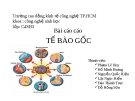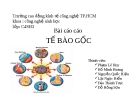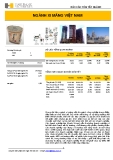
It is a rare treat when a drug discovery
program teaches us something about
the biology of the process that it
attempts to modulate. The paper by
Maria Frank-Kamenetsky and col-
leagues in this issue of the Journal of
Biology [1] presents a compelling
example of how the search for thera-
peutics can provide powerful experi-
mental tools and insights into
fundamental biology, blurring the dis-
tinction between applied and basic
research. By characterizing a small
group of chemically similar agonists of
the Hedgehog signaling pathway,
Frank-Kamenetsky et al. have been able
to propose a new model for how the
Smoothened component of the
Hedgehog-receptor complex works,
and to hint at the existence of natural-
ligand agonists of the Hedgehog
signaling pathway (see ‘The bottom
line’ box for a summary of their work).
Hedgehog history
Signaling by the Hedgehog (Hh)
family of secreted proteins plays a
central role in regulating cell differenti-
ation and tissue patterning during
development [2]. The hedgehog gene
(hh) was first identified by virtue of its
role in the specification of positional
identity during Drosophila embryonic
segmentation, and it was subsequently
found to control patterning of struc-
tures such as the eye and the abdominal
cuticle. In mammals there are three hh
homologs, called Sonic Hedgehog,
Indian Hedgehog and Desert Hedgehog
(Shh, Ihh and Dhh, respectively), which
have been implicated in patterning
events in a range of developing tissues
(see the ‘Background’ box) [2,3].
Recently, signaling by Hh has been
shown to be important for patterning
of the cerebellum, where it promotes
the proliferation of granule neuron
precursors. A link between Hh proteins
and stem-cell proliferation has raised
Research news
Agonizing Hedgehog
Jonathan B Weitzman
BioMed Central
Journal
of Biology
An approach using ‘chemical genetics’ has identified small-molecule agonists of the Hedgehog
signaling pathway that may lead the way to drugs for chronic degenerative diseases.
Published: 6 November 2002
Journal of Biology 2002, 1:7
The electronic version of this article is the
complete one and can be found online at
http://jbiol.com/content/1/2/7
© 2002 BioMed Central Ltd ISSN 1475-4924
Journal of Biology 2002, 1:7
The bottom line
•Frank-Kamenetsky and colleagues designed a cell-based, high-throughput
assay to screen 140,000 compounds to find modulators of the Hedgehog
signaling pathway.
•They identified a small group of related synthetic non-peptidyl molecules
that can act as agonists of Hedgehog signals at nanomolar concentra-
tions, having previously identified small-molecule Hedgehog antagonists.
•A range of in vitro and in vivo assays were used to show that the
agonists can be used as drugs to overcome Hedgehog-signaling defects
and to promote cell proliferation.
•The action of the agonist compounds is independent of the Hedgehog
ligand and the inhibitory receptor Patched. Further characterization
revealed that the agonists bind directly to the receptor Smoothened.
•These data give new insights into the nature of Hedgehog-Smoothened
signaling and raise the possibility of analogous endogenous modulators
of Hh signaling.

the enticing possibility that modulating
Hh signaling might be relevant for the
clinical management of certain degener-
ative diseases. Indeed, it was recently
demonstrated that Shh might be effec-
tive in treating peripheral nerve damage
or degenerative brain disorders such as
Parkinson’s disease [4,5]. Perhaps not
surprisingly given its role in develop-
ment, misregulated Hh signaling has
also been implicated in cancer [3].
Specifically, medulloblastoma and basal
cell carcinoma (BCC) are associated
with inappropriate activation of Hh sig-
naling [6,7]. These observations moti-
vated Frank-Kamenetsky and colleagues
to search for small-molecule modula-
tors of the Hh pathway, with the hope
that antagonists and agonists might be
used as drugs to treat proliferative or
degenerative diseases, and that small
molecules might prove more amenable
to pharmacological delivery than the
Hh-family proteins themselves.
Sending the signal
Hedgehog signaling challenges the
way we normally think about signal
transduction pathways. Biology is full
of examples of extracellular ligands
that bind to specific cell-surface recep-
tors, initiating a cascade of biochemi-
cal events (often involving protein
kinases) that leads to the activation of
a transcription factor and the induc-
tion of a set of effector genes. But
Hedgehog signaling is not so simple.
Even the ligand is complicated: the
Hh proteins undergo unusual process-
ing and cleavage to generate an extra-
cellular cholesterol-linked peptide
that serves as the signaling ligand [2].
And the receptor component is far
from understood.
The cellular response to Hh is con-
trolled by two transmembrane pro-
teins, Patched (Ptc) and Smoothened
(Smo). The Ptc protein weaves across
the cell membrane twelve times and
resembles some transmembrane chan-
nels. It acts as a negative regulator of
the Hh signal and has been defined as
a tumor-suppressor. In contrast, Smo is
a proto-oncogene and activates signal-
ing in response to Hh ligand. The Smo
protein is a seven-transmembrane
receptor that resembles conventional G-
protein-coupled receptors (Figure 1a).
It appears that Ptc inhibits Smo,
although the precise mechanisms are
unclear. Hh stimulation relieves Smo
from inhibition by Ptc, leading to the
generation of an intracellular signal
that culminates in a nuclear transcrip-
tional response (Figure 1b). When Ptc
is removed the pathway is constitu-
tively ‘on’, independent of the Hh
ligand, whereas certain mutations in
Smo can activate Hh signaling, bypass-
ing Ptc regulation. A heteromeric
receptor model has been proposed, in
which Hh interacts directly with Ptc
and thereby affects the interaction of
Ptc with Smo [8]. “But things look
much more complicated than we had
earlier thought,” says Philip Beachy
(Johns Hopkins University School of
Medicine, Maryland, USA). “The previ-
ous models are not tenable,” and he
suggests that alternative models of
receptor function must be considered.
The power of chemical
genetics
Frank-Kamenetsky et al. [1] chose to
use chemical genetics in an attempt to
identify compounds that could inter-
fere with the inhibition of Smo by Ptc,
or could activate Smo independent of
Ptc, or that might act downstream of
Smo. In addition to making effective
drug candidates, these molecules might
also help to illuminate the complex
mechanisms underlying signaling by
Hh, Ptc, and Smo (see the ‘Behind the
scenes’ box for more of the background
to the work).
The high-throughput screen was
elegantly simple. First, Frank-Kamenetsky
7.2 Journal of Biology 2002, Volume 1, Issue 2, Article 7 Weitzman http://jbiol.com/content/1/2/7
Journal of Biology 2002, 1:7
Background
•Mammals have three Hedgehog (Hh) proteins (Sonic Hedgehog,
Indian Hedgehog and Desert Hedgehog) that are processed to
generate functional extracellular ligands. Two receptors are involved in
Hh signaling: Patched (Ptc) is a negative regulator of the Hh-triggered
signaling pathway and Smoothened (Smo) is a positive activator
(Hh, Ptc and Smo were all originally named for the cuticular pheno-
types of mutant Drosophila larvae). When Hh ligands bind to Ptc they
relieve the negative inhibition and Smoothened initiates a signaling
cascade that results in the activation of nuclear transcription factors of
the Gli family that regulate effector gene transcription (see Figure 1).
•Hh signaling has been implicated in a wide range of developmental
processes. Small-molecule modulators of Hh signaling are
potential candidates as therapeutic drugs to treat human diseases –
molecules that mimic Hh signaling (agonists) might be used to treat
degenerative disorders such as Parkinson’s disease, whereas
blockers (antagonists) could be used as drugs against certain types
of cancer.
•Chemical genetics uses synthetic small molecules to dissect cellular
functions such as signal transduction pathways. By analogy with loss-
and gain-of-function mutations in genetics, the functional interactions
between chemical inducers and inhibitors is used to define the
hierarchical relationship between protein components of the pathway.

et al. identified a cell line that responds
well to Hh stimulation. The introduc-
tion of a reporter gene (encoding the
firefly luciferase protein) that was
turned on by Hh signaling permitted
screening for compounds that block or
induce signaling by monitoring the
expression of the luciferase protein
(using a simple luminescence test).
They had previously used such a screen
to isolate antagonists of Hh signaling,
and had demonstrated the effective-
ness of some antagonists as potential
anti-tumor drugs to treat BCC [7].
Their new screen of 140,000 synthetic
compounds led to the discovery of a
few candidate agonists that could stim-
ulate the reporter gene and mimic
Hh activity.
Once the cell-based screen was com-
pleted, the chemists took over, synthe-
sizing 300 derivative molecules until
they found a few compounds that were
related to the previous ‘best’ agonist
but that were a thousand times more
effective at eliciting a cellular response,
affecting cells when applied in the
nanomolar range. “Getting more
potent compounds was essential if we
were to figure out where the agonists
were acting” recalls Jefferey Porter who
headed the team at Curis, Inc.
Then the cell biologists began
again, studying the effects of the ago-
nists on the proliferation of primary
neonatal cerebellar granule neuron
precursors. They monitored the incor-
poration of tritiated thymidine into
cultured rat neurons (as a marker of
DNA synthesis and hence prolifera-
tion) and were pleased to see that the
agonists were as effective in this assay
as the Hh protein itself. An assay using
an explant of embryonic neural plate
was used to confirm that the agonists
could induce dose-dependent gene
expression in neural precursors, just as
the Shh protein does.
Having established the effects of
the agonists in culture assays,the
researchers then turned to an in vivo
model, feeding the compounds to
pregnant mice and following the
effects on the phenotypes of embryos
lacking Shh or Smo. The treated
embryos displayed activated Hh sig-
naling, demonstrating that the com-
pounds were not toxic and could
cross the placental barrier. The devel-
opmental defects of Shh-/- embryos
were rescued by treatment with the
agonist but the compound had no
effect on Hh signaling in the absence
of Smo.
“Once we knew that the agonists
were targeting Smo, we wanted to
investigate whether they bound to
Smo directly and how they activated
Hh signaling,” says Porter. The cell line
that was created for the screen served
as a useful tool to test the effects of
known antagonists on the function of
the agonist. An anti-Hh blocking anti-
body had no effect, so the agonist
must work downstream of the Hh-Ptc
interaction. But the agonist was
blocked by antagonists that work at
the level of Smo or further down-
stream. “We have similar conclusions,”
says Beachy, whose group used photo-
affinity labeling and cross-linking
experiments to show that small-
molecule agonists and antagonists
bind directly to Smo.
Next, for Frank-Kamenetsky et al., it
was time for some careful biochemistry.
Analysis of the expression of fusion
proteins of Ptc or Smo showed that,
unlike the Hh ligand itself, the agonist
had no effect on the stability of the Ptc
protein. In contrast, both Hh and the
agonist could increase the stability of
the Smo receptor. Immunoprecipita-
tion experiments with radiolabeled
agonist showed that the agonist must
bind directly to Smo receptors, and
that Hh-signaling inhibitors compete
with the agonist for binding. Pharmo-
kinetic analysis provided evidence for
a single binding site competition
model. Finally, Frank-Kamenetsky et
al. exploited an oncogenic, constitu-
tively active mutant form of Smo
http://jbiol.com/content/1/2/7 Journal of Biology 2002, Volume 1, Issue 2, Article 7 Weitzman 7.3
Journal of Biology 2002, 1:7
Figure 1
The Hedgehog signaling pathway. (a) In the absence of Hedgehog ligands, Patched protein inhibits
the activity of Smoothened, which resembles G-protein-coupled receptors. (b) On activation by a
ligand of the Hedgehog family, the inhibition of Smoothened by Patched is relieved and Smoothened
is freed to trigger an intracellular signaling cascade; this ultimately leads to transcriptional regulation
by transcription factors of the Gli family.
Dhh Shh Ihh
Hedgehog ligands
Effector gene
(a) (b)
Cytoplasm
Membrane
Nucleus
Gli
Patched Smoothened

(Smoact); the agonists bound equally
well to mutant and wild-type forms,
whereas the antagonist bound less well
to the mutant form.
Learning lessons from drugs
Frank-Kamenetsky et al. have demon-
strated convincingly that high-through-
put chemical genetics can be used to
isolate modulators of a developmental
signaling pathway. The agonists that
they have generated are efficient and
apparently non-toxic mimics of Hh
signals and are promising candidates
for drugs for regenerative medicine.
The authors work at the biotechnology
company Curis Inc. (Cambridge,
USA), so finding new drugs is obvi-
ously their primary objective. But the
agonists also provide useful tools for
probing the complex Hh-Ptc-Smo
signaling pathway.
“A lot of our biological insight is
driven by having specific chemical
inhibitors, and many drugs are used
as tools to dissect signaling systems as
a substitute for genetic studies,” says
Arnon Rosenthal (Rinat Neuroscience
Corp., Palo Alto, USA). Beachy agrees:
“these compounds, first the plant-
derived inhibitor cyclopamine and
more recently the agonists, have really
helped us to understand Smoothened
function.” Recent work from Beachy’s
lab [9,10], demonstrating that Ptc
suppresses Smo in catalytic manner,
has led to speculation that Ptc may
function as a transporter protein
pumping natural small-molecule Smo
modulators across the cell membrane.
Rosenthal adds that “good basic
research always leads to better medi-
cines, since the more we understand
about the mechanisms operating in
the body, the better able we are to
modulate them rationally.”
The data presented by Frank-
Kamenetsky et al. [1] led them to
propose a new model for Hh signaling
based on the classic ‘ternary complex
model’ that was developed to describe
ligand-induced conformational changes
of G-protein-coupled receptors [11].
According to this model, active and
inactive conformations of Smo are
selected by the binding of agonists
or antagonists at independent sites.
Furthermore, the model predicts that
Smo binds to a novel effector molecule
7.4 Journal of Biology 2002, Volume 1, Issue 2, Article 7 Weitzman http://jbiol.com/content/1/2/7
Journal of Biology 2002, 1:7
Behind the scenes
Journal of Biology asked Jeff Porter, group leader at Curis Inc., to comment
on the background to the project to search for small-molecule modulators
of Hedgehog signaling.
What prompted you to set up a screen for agonists of the
Hedgehog pathway?
There was evidence that manipulating Hedgehog signaling might be useful
in a therapeutic context to treat degenerative neurological diseases. There
were promising data using modified Hedgehog ligands in animal disease
models, but we felt that a small molecule would be a more effective thera-
peutic. We had previously set up the cell-based assay to screen for antago-
nists of Hedgehog signaling and successfully isolated inhibitors that could
inhibit tumor growth. So we adapted the assay to find Hedgehog agonists.
What was your initial reaction to the results, and how were they
received by others?
This was a kind of ‘black box’ screen - we were looking for a change in a
biological readout, in contrast to traditional pharmacological screens that
focus on a particular target. So, we couldn’t be sure what type of molecule
we would get; we could have predicted that we’d find inhibitors of
Patched or stabilizers of Gli. I was surprised and excited when we realized
that our agonists were targeting Smoothened. Once we had nailed down
the target, there was a lot of interest in these compounds and what they
can teach us about Hedgehog signaling.
How long did the project take?
We began the screen in late 1999. It took a few months to get the initial
compounds, and then we began the process of making slow improve-
ments by chemical modification. Without the improvements we couldn’t
have figured out what was going on. We had to establish the techniques
and acquire the reagents necessary to characterize the agonists in detail.
The potent compound derivatives were also key to the success of the
cell-free binding assays - they look simple but the binding experiments
were very tricky.
What are the next steps?
We want to figure out the mechanisms of Smo regulation and signal trans-
duction - how Ptc talks to Smo and how Smo talks to Gli. And, of course,
we are also testing these molecules as potential therapeutics in animal
models of disorders of the central nervous system. The preclinical results
are promising: the compounds show low toxicity, they can be administered
orally and cross the blood-brain barrier. These compounds might also be
useful in ex vivo therapies to stimulate stem cell proliferation. I am optimistic
that Hedgehog agonists will be tested in human trials in the future.

and it raises the possibility that
endogenous ligands, analogous to the
newly found agonist, may naturally
regulate Smo activity.
Cheryll Tickle (University of Dundee,
UK) studies the role of Hh in develop-
ment and finds the possibility that there
are endogenous small-molecule agonists
that interact with Smoothened particu-
larly intriguing. “This would mean that
we are missing a whole layer of control
of Hedgehog signaling in our current
models,” she notes. Porter adds, “It is
tempting to speculate that endogenous
molecules act directly on Smo, bypass-
ing Ptc. That is consistent with what we
know about how G-protein-coupled
receptors work. But at the moment, it’s
pure speculation.”
The study by Frank-Kamenetsky et
al. [1] exploits a dazzling variety of
experimental techniques to illustrate
the path from high-throughput screen-
ing to compound characterization.
Biochemists, cell biologists, pharm-
acologists and chemists have come
together to demonstrate effectively that
‘drug discovery’ can combine all the
excitement of ‘real’ scientific discovery
with the satisfaction of isolating
compounds that might be used for
tomorrow’s therapies.
References
1. Frank-Kamenetsky M, Zhang XM,
Bottega S, Guicherit O, Wichterle H,
Dudek H, Bumcrot D, Wang FY, Jones F,
Shulok J, Rubin LL Porter JA: Small
molecule modulators of Hedgehog
signaling: identification and charac-
terization of Smoothened agonists
and antagonists. J Biol 2002, 1:10.
2. Ingham PW, McMahon AP: Hedgehog
signaling in animal development;
paradigms and principles. Genes Dev
2001, 15:3059-3087.
3. Taipale J, Beachy PA: The Hedgehog
and Wnt signaling pathways in
cancer. Nature 2001, 411:349-354.
4. Pepinsky RB, Shapiro RI, Wang S,
Chakraborty A, Gill A, Lepage DJ, Wen
D, Rayhorn P, Horan GS, Taylor FR, et al.:
Long-acting forms of Sonic hedge-
hog with improved pharmocokinetic
and pharmacodynamic properties
are efficacious in a nerve injury
model. J Pharm Sci 2002, 91:371-387.
5. Tsuboi K, Shults CW: Intrastriatal
injection of sonic hedgehog reduces
behavioural impairment in a rat
model of Parkinson’s disease. Exp
Neurol 2002, 173:95-104.
6. Berman DM, Karhadkar SS, Hallahan AR,
Pritchard JI, Eberhart CG, Watkins DN,
Chen JK, Cooper MK, Taipale J, Olson
JM, Beachy PA: Medulloblastoma
growth inhibition by Hedgehog
pathway blockade. Science 2002,
297:1559-1561.
7. Williams JA, Guicherit OM, Zaharian BI,
Xu Y, Chai L, Gatchalian C, Porter JA,
Rubin LL, Wang FY: Identification of
novel inhibitors of the hedgehog sig-
naling pathway: effects on basal cell
carcinoma-like lesions. Proc Natl Acad
Sci USA, in press.
8. Stone DM, Hynes M, Armanini M,
Swanson TA, Gu Q, Johnson RL, Scott
MP, Pennica D, Goddard A, Phillips H, et
al.: The tumor-suppressor gene
patched encodes a candidate recep-
tor for Sonic Hedgehog. Nature 1996,
384:129-134.
9. Chen JK, Taipale J, Young KE, Maiti T,
Beachy PA: Small molecule modula-
tion of Smoothened activity. Proc
Natl Acad Sci USA 2002, 99:14071-14076.
10. Taipale J, Cooper MK, Maiti T, Beachy
PA: Patched acts catalytically to sup-
press the activity of Smoothened.
Nature 2002, 418:892-896.
11. De Lean A, Stadel JM, Lefkowitz RJ: A
ternary complex model explains the
agonist-specific binding properties
of the adenylate cyclase-coupled
beta-adrenergic receptor. J Biol Chem
1980, 255:7108-7117.
Jonathan B Weitzman is a scientist and science
writer based in Paris, France.
E-mail: jonathan.weitzman@hotmail.com
http://jbiol.com/content/1/2/7 Journal of Biology 2002, Volume 1, Issue 2, Article 7 Weitzman 7.5
Journal of Biology 2002, 1:7





![Mẫu đề cương chi tiết sinh viên thực tế tại doanh nghiệp [chuẩn nhất]](https://cdn.tailieu.vn/images/document/thumbnail/2014/20140523/duongxuan92/135x160/1681621_356.jpg)













![Báo cáo môn học Công Nghệ Di Truyền [năm] [trường] (hoặc: Mới nhất/Chi tiết)](https://cdn.tailieu.vn/images/document/thumbnail/2013/20130225/trautuongquan/135x160/8601361760920.jpg)






![Báo cáo seminar chuyên ngành Công nghệ hóa học và thực phẩm [Mới nhất]](https://cdn.tailieu.vn/images/document/thumbnail/2025/20250711/hienkelvinzoi@gmail.com/135x160/47051752458701.jpg)









